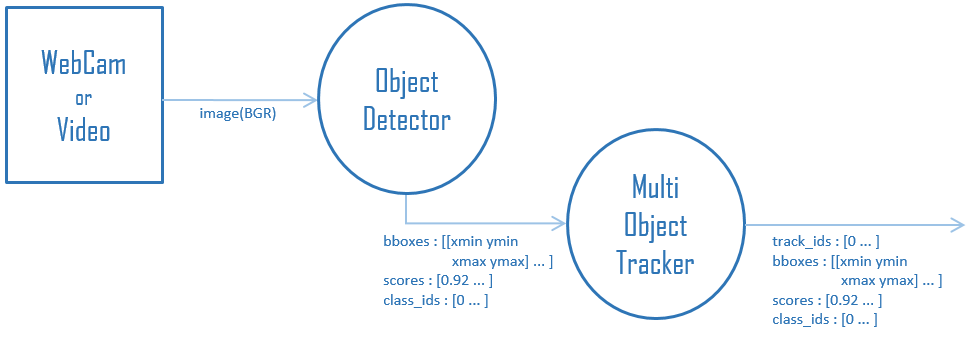Morphable Detector for Object Detection on Demand
(ICCV 2021) PyTorch implementation of the paper Morphable Detector for Object Detection on Demand.
If our project is helpful for your research, please consider citing:
@inproceedings{zhaomorph,
author = {Xiangyun Zhao, Xu Zou, Ying Wu},
title = {Morphable Detector for Object Detection on Demand},
booktitle = {ICCV},
Year = {2021}
}
Install
First, install PyTorch and torchvision. We have tested on version of 1.8.0 with CUDA 11.0, but the other versions should also be working.
Our code is based on maskrcnn-benchmark, so you should install all dependencies.
Data Preparation
Download large scale few detection dataset here and covert the data into COCO dataset format. The file structure should look like:
$ tree data
dataset
├──fsod
├── annototation
│
├── images
Training (EM-like approach)
We follow FSOD Paper to pretrain the model using COCO dataset for 200,000 iterations. So, you can download the COCO pretrain model here, and use it to initilize the network.
We first initialize the prototypes using semantic vectors, then train the network run:
export NGPUS=2
RND_PORT=`shuf -i 4000-7999 -n 1`
CUDA_VISIBLE_DEVICES=0,1 python -m torch.distributed.launch --master_port $RND_PORT --nproc_per_node=$NGPUS ./tools/train_sem_net.py \
--config-file "./configs/fsod/e2e_faster_rcnn_R_50_FPN_1x.yaml" OUTPUT_DIR "YOUR_OUTPUT_PATH" \
MODEL.RPN.FPN_POST_NMS_TOP_N_TRAIN 2000 SOLVER.IMS_PER_BATCH 4 SOLVER.MAX_ITER 270000 \
SOLVER.STEPS "(50000,70000)" SOLVER.CHECKPOINT_PERIOD 10000 \
SOLVER.BASE_LR 0.002
Then, to update the prototypes, we first extract the features for the training samples by running:
export NGPUS=2
RND_PORT=`shuf -i 4000-7999 -n 1`
CUDA_VISIBLE_DEVICES=0,1 python -m torch.distributed.launch --master_port $RND_PORT --nproc_per_node=$NGPUS \
./tools/train_sem_net.py --config-file "./configs/fsod/e2e_faster_rcnn_R_50_FPN_1x.yaml" \
FEATURE_DIR "features" OUTPUT_DIR "WHERE_YOU_SAVE_YOUR_MODEL" \
FEATURE_SIZE 200 SEM_DIR "visual_sem.txt" GET_FEATURE True \
MODEL.RPN.FPN_POST_NMS_TOP_N_TRAIN 2000 \
SOLVER.IMS_PER_BATCH 4 SOLVER.MAX_ITER 80000 \
SOLVER.CHECKPOINT_PERIOD 10000000
To compute the mean vectors and update the prototypes, run
cd features
python mean_features.py FEATURE_FILE MEAN_FEATURE_FILE
python update_prototype.py MEAN_FEATURE_FILE
To train the network using the updated prototypes, run
export NGPUS=2
RND_PORT=`shuf -i 4000-7999 -n 1`
CUDA_VISIBLE_DEVICES=0,1 python -m torch.distributed.launch --master_port $RND_PORT --nproc_per_node=$NGPUS \
./tools/train_sem_net.py --config-file "./configs/fsod/e2e_faster_rcnn_R_50_FPN_1x.yaml" \
SEM_DIR "PATH_WHERE_YOU_SAVE_THE_PROTOTYPES" VISUAL True OUTPUT_DIR "WHERE_YOU_SAVE_YOUR_MODEL" \
MODEL.RPN.FPN_POST_NMS_TOP_N_TRAIN 2000 SOLVER.IMS_PER_BATCH 4 \
SOLVER.MAX_ITER 70000 SOLVER.STEPS "(50000,80000)" \
SOLVER.CHECKPOINT_PERIOD 10000 \
SOLVER.BASE_LR 0.002
Tests
After the model is trained, we randomly sample 5 samples for each novel category from the test data and use the mean feature vectors for the 5 samples as the prototype for that categpry. The results with different sample selection may vary a bit. To reproduce the results, we provide the features we extracted from our final model. But you can still extract your own features from your trained model.
To extract the features for test data, run
export NGPUS=2
RND_PORT=`shuf -i 4000-7999 -n 1`
CUDA_VISIBLE_DEVICES=0,1 python -m torch.distributed.launch --master_port $RND_PORT --nproc_per_node=$NGPUS \
./tools/train_sem_net.py --config-file "./configs/fsod/e2e_faster_rcnn_R_50_FPN_1x.yaml" \
FEATURE_DIR "features" OUTPUT_DIR "WHERE_YOU_SAVE_YOUR_MODEL" \
FEATURE_SIZE 200 SEM_DIR "visual_sem.txt" GET_FEATURE True \
MODEL.RPN.FPN_POST_NMS_TOP_N_TRAIN 2000 \
SOLVER.IMS_PER_BATCH 4 SOLVER.MAX_ITER 80000 \
SOLVER.CHECKPOINT_PERIOD 10000000
To compute the prototype for each class (online morphing), run
cd features
python mean_features.py FEATURE_FILE MEAN_FEATURE_FILE
Then run test,
export NGPUS=2
RND_PORT=`shuf -i 4000-7999 -n 1`
CUDA_VISIBLE_DEVICES=0,1 python -m torch.distributed.launch --master_port $RND_PORT --nproc_per_node=$NGPUS ./tools/test_sem_net.py --config-file "./configs/fsod/e2e_faster_rcnn_R_50_FPN_1x.yaml" SEM_DIR WHERE_YOU_SAVE_THE_PROTOTYPES VISUAL True OUTPUT_DIR WHERE_YOU_SAVE_THE_MODEL MODEL.RPN.FPN_POST_NMS_TOP_N_TRAIN 2000 FEATURE_SIZE 200 MODEL.ROI_BOX_HEAD.NUM_CLASSES 201 TEST_SCALE 0.7
Models
Our pre-trained ResNet-50 models can be downloaded as following:
| name | iterations | AP | AP^{0.5} | model | Mean Features |
|---|---|---|---|---|---|
| MD | 70,000 | 22.2 | 37.9 | download | download |
| name | iterations | AP | AP^{0.5} | Mean Features |
|---|---|---|---|---|
| MD 1-shot | 70,000 | 19.6 | 33.3 | download |
| MD 2-shot | 70,000 | 20.9 | 35.7 | download |
| MD 5-shot | 70,000 | 22.2 | 37.9 | download |





